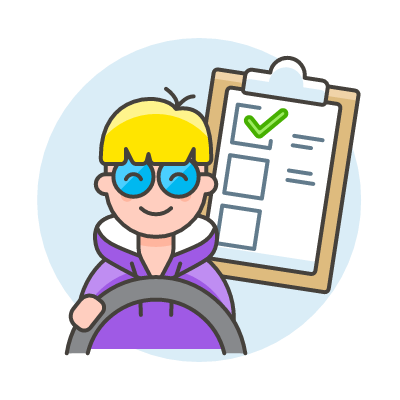SGI Air Brake Practice Test Part 4
Preparing for your Saskatchewan Air Brake Endorsement (Code A)? Our free, up-to-date SGI Air Brake Practice Test are built to help you succeed on your first try with full confidence.These tests are based on the Official Saskatchewan Air Brake Manual, your most trusted guide to understanding air brake systems, learning proper inspection procedures, and mastering the critical safety rules required for commercial drivers in Saskatchewan.

Report a question

What to Expect on the Official Saskatchewan Air Brake (Endorsement A) Knowledge Test
To obtain the Air Brake Endorsement (Code A) on your Saskatchewan commercial driver’s licence, you must pass both a written knowledge test and a practical air brake inspection. Here’s what you can expect for the written portion:
Number of Questions
25
Time Limit
45 minutes
Passing Score
80%
Based On
Where to Write
Frequently Asked Questions – Saskatchewan Air Brake Practice Test
The Air Brake Endorsement (Code A) is required for drivers operating commercial vehicles equipped with air brake systems in Saskatchewan. It’s added to your driver’s licence after you pass both a written knowledge test and a practical air brake inspection.
The written test contains 25 multiple-choice questions based on the official Saskatchewan Air Brake Manual. A score of 80% or higher (20 correct answers) is required to pass.
You can write the test at any SGI Driver Exam Office or SGI-approved testing location across Saskatchewan. Appointments may be required, so it’s best to check with your nearest office.
The test includes questions on:
Air brake components (compressor, tanks, brake chambers, etc.)
System operation and warning devices
Daily pre-trip inspections
Emergency procedures
Safe driving practices with air brakes
Yes, you’ll have 45 minutes to complete the 25-question multiple-choice test.
In addition to the written test, you must demonstrate a hands-on inspection of an air brake system. This includes identifying components, checking for leaks, and explaining system functions. You must pass this to receive the endorsement.
Study the Saskatchewan Air Brake Manual thoroughly and take multiple free online practice tests like the ones on our site. These practice quizzes simulate the real test format and help reinforce your knowledge.
While other provinces have similar systems, it’s best to study the official Saskatchewan Air Brake Manual. Saskatchewan follows its own SGI guidelines and inspection standards, so using the correct manual ensures you’re learning the right material for your test.
If you don’t pass, you’ll need to rebook the test and pay a retesting fee. You must wait at least one day before retaking the written test. It’s important to review the manual and practice again to
Once you earn the Code A endorsement, it remains valid as long as your Saskatchewan commercial driver’s licence is active. There’s no separate expiry for the endorsement, but you must maintain a valid licence and medical fitness to continue driving commercial vehicles with air brakes.
Free Saskatchewan Commercial Test Practice – Air Brake (Code A) Endorsement for Class 1, 2, 3, and 4 Drivers
Getting your Air Brake Endorsement (Code A) in Saskatchewan is a key step toward operating commercial vehicles like semi-trucks, school buses, and transit vehicles. Before hitting the road, you’ll need to pass both the SGI-written air brake knowledge test and a practical inspection.
Our Saskatchewan Air Brake Practice Test is built specifically for SGI standards—designed to help you pass on your first attempt by mastering all key topics from the official Saskatchewan Air Brake Manual.
Why Choose Our Saskatchewan Air Brake Practice Test?
✅ 100% Based on the Saskatchewan Air Brake Manual
✅ Same format as the real SGI test
✅ 25 multiple-choice questions per test
✅ Instant feedback to accelerate your learning
✅ Unlimited free attempts—no registration needed
✅ Accessible from any device
Perfect for Drivers Who Are:
Studying for the Air Brake (Code A) Endorsement in Saskatchewan
Upgrading to a Class 1, 2, 3, or 4 commercial licence
Transitioning from another province (e.g. Manitoba)
Looking for trusted and up-to-date Saskatchewan Air Brake Practice Test material
Ready to Start?
The path to earning your Saskatchewan Air Brake Endorsement begins right here.
👉 Take the Saskatchewan Air Brake Practice Test Now
📘 Download the Official Saskatchewan Air Brake Manual (PDF)
📺 Watch Our Test Prep Videos on YouTube: @CanadianDriverKnowledgeTest
🌐 Visit: canadiandriverknowledgetest.ca
Air Brake System Components — Know Your Parts Inside and Out
Understanding system parts is key to passing your Saskatchewan Air Brake Practice Test and driving safely.
Air Compressor: Builds air pressure, regulated by the governor.
Air Tanks (Reservoirs): Must be drained daily in Saskatchewan to prevent moisture-related issues.
Brake Chambers: Convert air pressure into mechanical force.
Slack Adjusters: Maintain proper pushrod stroke and must be inspected.
Governor: Controls cut-in (~85 psi) and cut-out (~135 psi) pressure.
Safety Valve: Releases pressure at ~150 psi to prevent system failure.
🔧 Tip: SGI examiners may ask you to locate and describe these components during your practical test.


Daily Air Brake Inspections & Leak Tests — Safety Starts Here
Daily inspections are required by SGI and federal regulations.
Drain Tanks: Remove moisture and prevent freezing.
Visual Inspection: Check tanks, hoses, valves, and slack adjusters.
Low-Air Warning: Must activate near 60 psi.
Leak Test Standards:
Single vehicle: 3 psi/min
Combination unit: 4 psi/min
⚠️ Test Alert: Not knowing proper inspection steps is one of the top reasons students fail the Saskatchewan Air Brake Practice Test.
Common Brake System Failures & Emergency Protocols — Know What To Do
Commercial drivers must respond quickly to air brake system problems.
Low Pressure: Spring brakes apply automatically. Stop immediately.
Brake Fade: Often caused by overheating on hills. Use engine braking and snub braking.
Dragging Brakes: Caused by stuck valves or chambers.
📌 Pro Tip: Always be prepared to explain how you’d respond in emergency scenarios—this is frequently tested.ain your response clearly.


Air Pressure Gauges & Monitoring — Master the Instruments
Know how to read and react to gauge readings.
Primary/Secondary Gauges: Show system pressure.
Governor Operation: Understand how to check cut-in and cut-out.
Low-Air Warning: Must activate at 60 psi or higher.
💡 Did You Know? The SGI knowledge test often includes questions about interpreting air gauge readings under different driving conditions.
Spring Brakes & Emergency Braking — Ontario’s Last Line of Defense
Spring brakes automatically engage when air pressure drops too low.
Activate around 60 psi
Used for parking and emergencies only
Not for regular braking
🛑 Tip: Never use spring brakes for normal driving. You’ll be tested on this during both written and practical SGI exams.


Dual Air Brake Systems — Redundancy Saves Lives
Dual systems prevent total brake failure.
Two Circuits: Often front and rear
Two Air Reservoirs: Must be independently pressurized
Warning Devices: Know what lights and buzzers signal failure
📘 Test Tip: Expect at least one question on dual brake system operation during your Saskatchewan Air Brake Practice Test.
Manual vs Automatic Slack Adjusters — Inspection & Adjustment
Both types must be inspected regularly.
Manual Adjusters: Require manual stroke checks and adjustments.
Automatic Adjusters: Self-adjust but still need verification.
📏 Pro Tip: You may be asked to measure pushrod stroke on your SGI practical test. Max stroke is typically 1 inch (25 mm).


Safe Driving Techniques with Air Brakes — Prevent Brake Failure
Air brakes can overheat and fail without proper driving technique.
Snub Braking: Apply firmly, then release to cool.
Avoid Brake Riding: Especially on long descents.
Downshifting: Use engine braking to control speed.
🚦 Did You Know? These safe driving habits are tested both in the SGI written exam and practical training evaluations.
Moisture & Freezing in Air Brake Systems — Ontario Winter Hazards
Saskatchewan’s cold weather poses a real challenge for air brake systems.
Drain Air Tanks: Moisture can freeze and block lines.
Use Air Dryers: Helps remove water from the system.
Check for Freezing: Watch for sluggish response in cold starts.
❄️ Winter Tip: You’ll likely face a cold-weather system question on your Saskatchewan Air Brake Practice Test—be ready.


Preparing for Ontario’s Practical Air Brake Test — Hands-On Skills You Need
You must pass a hands-on SGI air brake test to earn your Code A Endorsement.
Pressure Build-Up Time
Governor Cut-In/Cut-Out Test
Low-Air Warning System Check
Spring Brake Activation Test
Applied Pressure Leak Test
Pushrod Stroke Measurement
Full Brake System Walk-Around
✅ Confidence Tip: The more you practice these procedures, the easier the test becomes. Master each one before your exam day.
